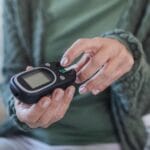Type 2 diabetes affects the body’s ability to produce insulin, which is a hormone that helps the body break down sugar. Although people with type 2 diabetes still produce insulin, they don’t produce enough. They continuously monitor glucose levels via finger pricks and administer insulin injections as needed.
These constant finger pricks and injections can be uncomfortable. Researchers from the National Institute of Biomedical Imaging and Bioengineering (NIBIB) have developed a pain-free solution to monitoring glucose levels for individuals with type 2 diabetes.
The pain-free solution developed by the research team is a dissolvable microneedle patch that regulates blood sugar for days at a time. The patch is made of mineralized compounds that —once applied—react to blood chemistry to manage glucose levels automatically.
The base of the patch is made from alginate, a natural substance extracted from brown algae, which is poured into a microneedle form. It is just hard enough to poke through the dermis, or first two layers of the skin.
The alginate is infused with biochemical particles that stimulate the body’s own insulin production when needed and decrease stimulation when normal blood sugar concentration is reached.
The patch contains two different drug compounds, which are exendin-4 and glucose oxidase. Exendin-4 is similar to a molecule the body naturally produces and secretes in the intestine in response to food. Although extendin-4 is weaker than the naturally-occurring molecule, it lasts longer. However, in high doses, exendin-4 can cause nausea. This was one of the first problems that the patch had to address. The research team combined exendin-4 with calcium phosphate to stabilize it. Glucose oxidase, the second drug compound in the patch, is held in a mineral buffer of copper phosphate.
This is how the process works:
- An individual eats food, which causes blood sugar levels to rise.
- When blood sugar levels reach a specific point, they trigger a reaction with copper phosphate and glucose oxidase to create slight acidity.
- This acidity triggers the calcium phosphate to release some of the extendin-4.
- Extendin-4 triggers insulin production, which reduces glucose levels.
- Lower blood sugar levels, in turn, slow down and stop the release of extendin-4.
The patch is a responsive system because it turns on when it reacts with high blood sugar levels and turns itself off when the problem is alleviated. So far, the patch has been proven effective on mice; a patch the size of half an inch square monitored blood levels for one week. The team is looking forward to testing this treatment on larger animals, which would require modification of the size of the patch, the amount of drugs it contains, and the size of the microneedles.
Type 2 diabetes is the most common form of diabetes. This patch could be a pain-free solution to an illness that is affecting millions of Americans.
Sources





